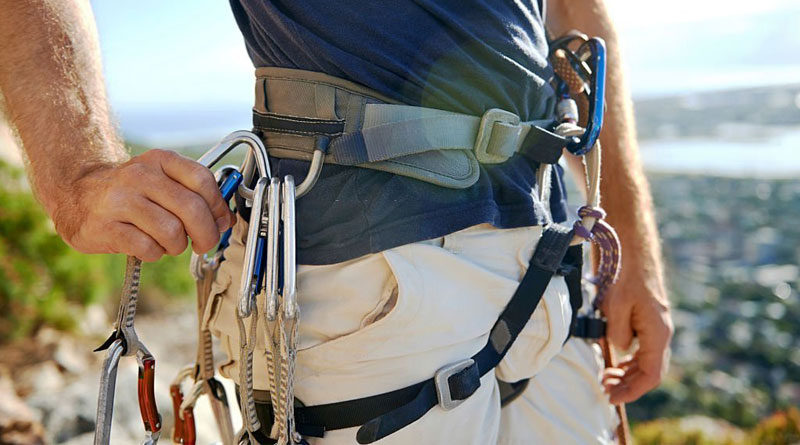Alpine Harness vs. Climbing Harness: A Comparison
A climbing harness and an alpine harness are both designed to provide a secure connection between the climber and a rope or anchor system, but they are optimized for different types of climbing.
A climbing harness is a multi-purpose harness that can be used for a variety of climbing activities such as indoor climbing, sport climbing, and trad climbing. Climbing harnesses are lightweight and comfortable, with adjustable leg loops and waistbands that allow you to tailor the fit to your specific needs. They usually have several gear loops and attachment points for carrying gear, as well as a belay loop to connect to a belay device.
In contrast, an alpine harness is specifically designed for use in alpine and mountaineering environments. Because they are intended for use in situations where weight and packability are important. These harnesses are typically more minimalistic than climbing harnesses. Alpine harnesses typically have fewer gear loops and attachment points and are made of lighter materials to save weight. They may also have a drop-seat design, which allows you to relieve yourself without removing the harness completely.
Weight and Packability
Climbing harnesses are typically designed to be lightweight and comfortable. However, the multiple gear loops and attachment points they feature can add weight. This added weight can be an issue for climbers who are traveling to and from the climbing area. They may need to carry their harnesses and other gear in a backpack.
Alpine harnesses, on the other hand, are designed with weight reduction in mind. They typically have fewer gear loops and attachment points and are made of lightweight materials to make packing and carrying in a backpack easier. This makes them an excellent choice for climbers who need to reduce their weight and pack size for long approaches or multi-day alpine or mountaineering expeditions.
Because of their minimalistic design, alpine harnesses are more compact than climbing harnesses in terms of packability. This makes them easier to pack into a backpack, which is important for climbers who must carry their gear over long distances.
Gear Loops and Attachment Points
Climbing harnesses typically have multiple gear loops and attachment points. This allows you to carry all of the gear and equipment you’ll need for your climb. Quickdraws, carabiners, slings, nut tools, and other equipment may be included. Climbers can carry all of their gear thanks to the extra gear loops and attachment points, which are especially useful on long or multi-pitch climbs.
Alpine harnesses, on the other hand, are designed with fewer gear loops and attachment points. This can make carrying all of your gear more difficult, especially on longer or multi-day climbing trips. However, the reduced weight and packability of an alpine harness can be a significant benefit for climbers traveling to and from the climbing area, as it makes carrying their gear over long distances easier.
Comfort and Adjustability
Climbing harnesses are comfortable and adjustable, with features like adjustable leg loops and waistbands. Climbers can find the perfect fit for their body and adjust the harness as needed during the climb. A climbing harness’s extra padding and comfortable design can make it a good choice for long or difficult climbs where comfort is important.
In contrast, alpine harnesses are designed to be minimalistic, with less padding and a lighter design. This can make them less comfortable than climbing harnesses, especially for long or demanding climbs. However, the minimalistic design of an alpine harness can also make it more breathable, which can be a major advantage for climbers who are climbing in hot or humid conditions.
Purpose and Environment
Climbing harnesses are designed for a wide range of climbing activities, including sport climbing, trad climbing, and multi-pitch climbing. They are typically used in a climbing gym or in outdoor climbing areas, where climbers are ascending a rock face or wall. Climbing harnesses are designed for climbing at all levels, from beginner to advanced, and are available in a range of styles and sizes to meet the needs of different climbers.
Alpine harnesses, on the flip side, are made for climbing conditions that are more difficult, such as ice climbing, mountaineering, and alpine climbing. They are frequently used in high-altitude settings where climbers must transport their equipment over long distances and ascend in challenging weather. Alpine harnesses are made with a minimalistic design that makes them lightweight and packable, reducing weight and making it simpler to carry equipment over long distances.
Conclusion
In conclusion, alpine harnesses and climbing harnesses are both essential pieces of equipment for climbers, but they serve different purposes and are designed for different environments. Alpine harnesses are lightweight, packable, and minimalistic, making them ideal for alpine climbing, mountaineering, and ice climbing in harsh, high-altitude environments. Climbing harnesses, on the other hand, are designed for a wide range of climbing activities and are more comfortable, adjustable, and versatile, with ample gear loops and attachment points.
It’s crucial to take your personal needs and the kind of climbing you’ll be doing into account when deciding between an alpine harness and a climbing harness. A climbing harness is probably a better option if you need a harness that is comfortable, flexible, and adjustable. An alpine harness is the better choice if you’re looking for a lightweight, packable harness for mountaineering or alpine climbing.
No matter which harness you choose, make sure it fits properly, is comfortable to wear, and meets the safety standards of your climbing environment. With the right harness, you’ll be able to focus on the climb and enjoy a safe and successful climbing experience.




